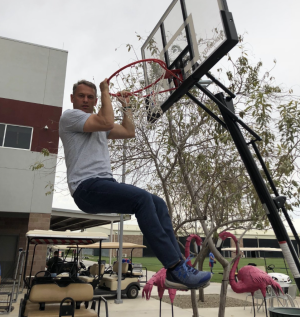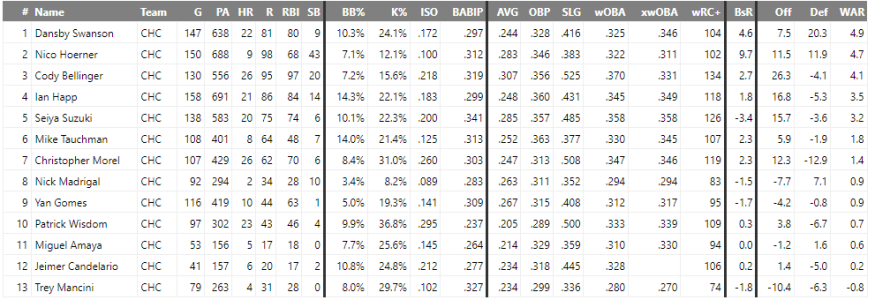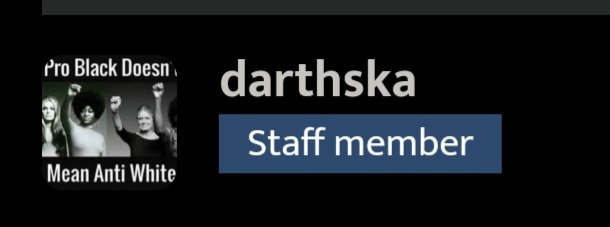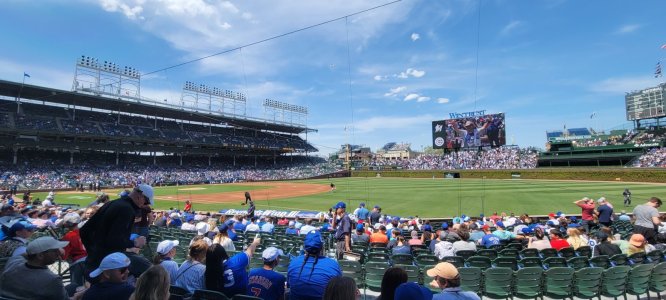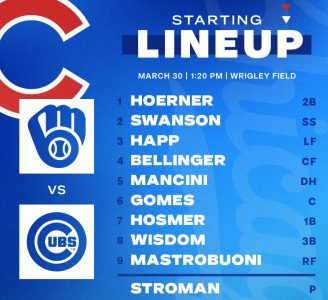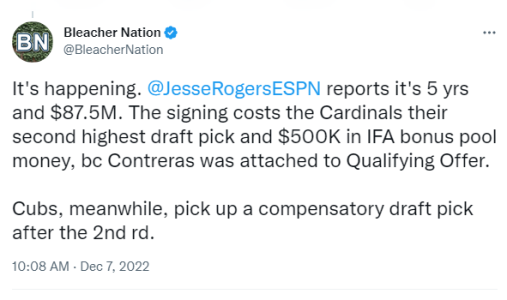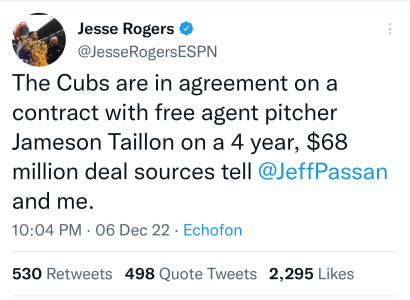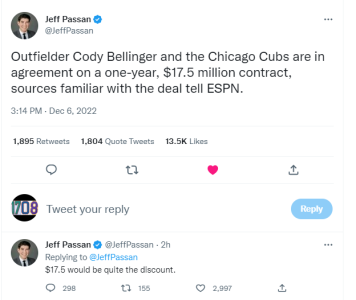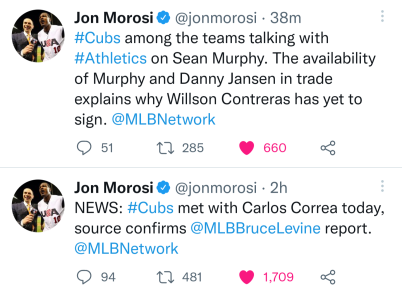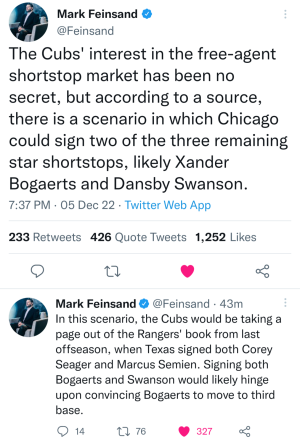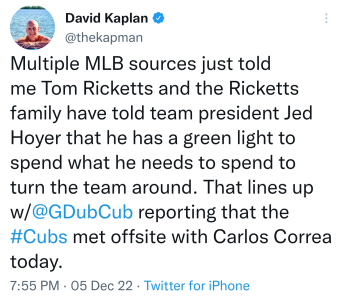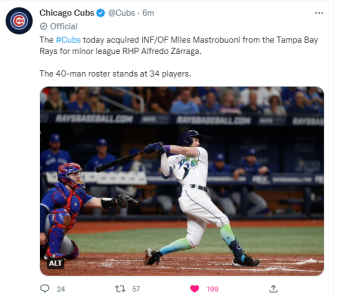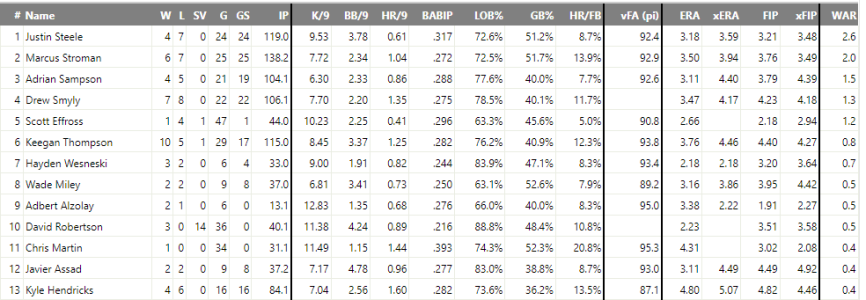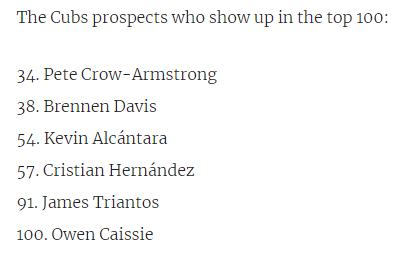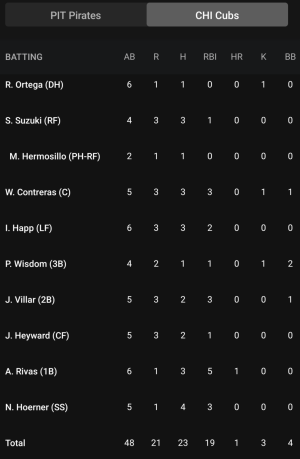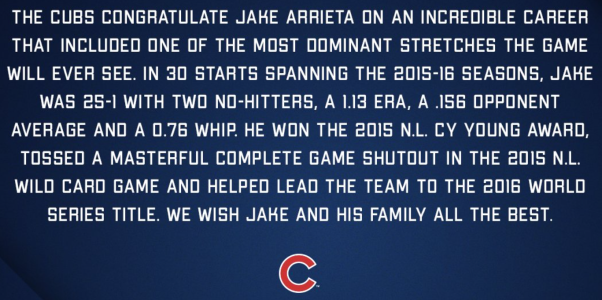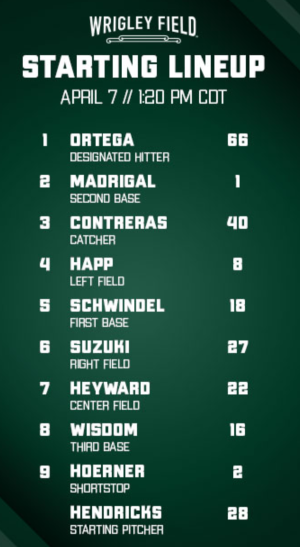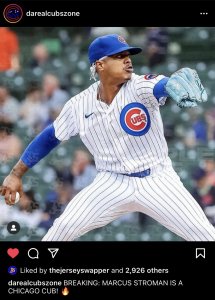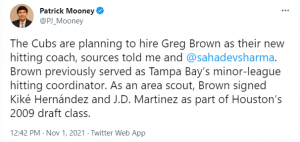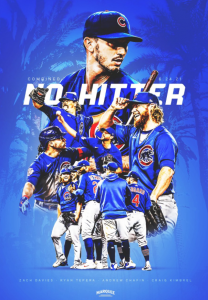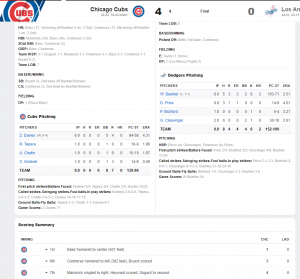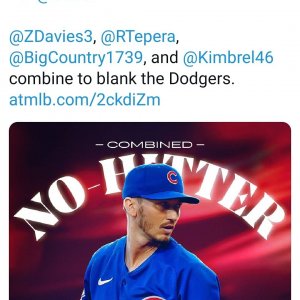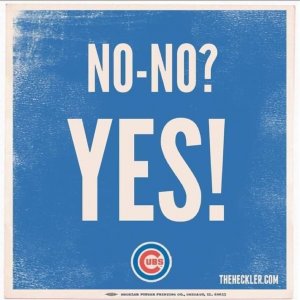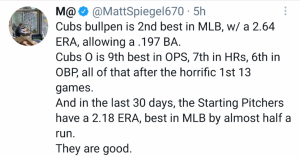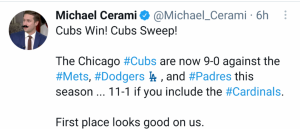Navigation
Install the app
How to install the app on iOS
Follow along with the video below to see how to install our site as a web app on your home screen.

Note: this_feature_currently_requires_accessing_site_using_safari
More options
You are using an out of date browser. It may not display this or other websites correctly.
You should upgrade or use an alternative browser.
You should upgrade or use an alternative browser.
Official 2023 Chicago Cubs Season Thread Vol: (17-17)
- Thread in 'Sports & Training' Thread starter Started by CP1708,
- Start date
Halfway through the summer of 2013, the big-league Cubs were in full-blown rebuild mode, stumbling through a summer schedule that contributed mightily to the team’s 96 losses that season. It wasn’t a pretty time in Chicago, and it was stuck smack dab in the middle of a series of seasons that, at least at Wrigley, featured little to get excited about.
But in the backfields of Venezuela and the Dominican Republic, big things were happening. That same summer of 2013, the Cubs signed two top young players—Gleyber Torres and Eloy Jimenez—for a combined $4.5 million (plus associated taxes), and the chance to be a part of what was, even then, well on its way to becoming the best farm system in baseball. Two years later, although graduations have dropped the Cubs’ system out of the top spot (this, of course, is by far the best way for a system to drop) Torres and Jimenez have played a big role in keeping Chicago’s minor-league talent an organizational strength and point of pride.
Just last week, BP ranked Torres the 41st-best prospect in baseball, on the strength of a 2015 campaign that saw him triple-slash .293/.353/.386 over 500+ plate appearances at Low-A South Bend, and end the year with a brief taste of High-A Myrtle Beach. Jimenez had a quieter season at Short-Season Eugene, slashing .284/.328/.418 over 250 plate appearances, but the Cubs are still very happy with what they’ve seen from both through one professional season, and are ready to watch them further develop their talents in 2016.
“In the case of Gleyber and Eloy, as is the case with most teenagers, you are seeing their frames fill into what they could be in the future,” Cubs’ Assistant Director of Player Development & International Scouting Alex Suarez told me. “With that said, the biggest change to their skill sets [since they came into the organization] has been at the plate with their bat speed and the way the ball comes off the bat. In terms of the skill profile, they seem to settling into their positions defensively, but the skill sets they showed as amateurs [at the plate] have been almost the same.”
That’s good news for the Cubs, and a credit to the strength and conditioning staff they’ve brought on board, because the skill sets these players showed as amateurs were very, very tempting. Jimenez is a big 6-foot-4, and makes Manny Ramirez (who he worked with in Arizona) look like a small man. Ramirez is manifestly not small—I’ve stood beside him, and felt as if I needed a footstool—but Jimenez is in a different category. When he gets his arms extended, he can already do some major damage. But big men often have trouble staying inside the ball and driving it the other way, and that’s something Jimenez is still working on, albeit from a high baseline.
“In Eloy’s case his power is certainly his biggest strength right now,” said Suarez. “As he continues learning the strike zone and his body with regards to his setup, you could see his frequency of hard contact going up as well his average. The swing path and his natural ability to drive balls to the right-center-field/right field is well advanced for his age.”
Advanced is a word that comes up a lot with both these players, but especially so with Torres. Suarez notes that “in Gleyber’s case [his strength is] definitely his hand-eye coordination coupled with an advanced understanding of the strike zone and what he can handle. His ability to stay behind the ball and make hard contact to all fields is really advanced for his age and level he played at.”
That said, in a perfect world, Torres wouldn’t have struck out 21 percent of the time at Low-A. Cutting down on strikeouts is thus something he’ll have to work on this season, but his makeup and preparation should help him get to a point where the problem is either solved or integrated into his game in such a way that it’s cancelled out by other strengths. You could argue (though I wouldn’t go that far, yet) that he’s already done that, given his age relative to the league and his strength defensively up the middle. For now, it’s just something to keep an eye on. If it persists higher up the organizational ladder, it’ll be worth revisiting with a bit more of a critical eye.
Both players, actually, have the makeup they’ll need to get to the highest level, which isn’t surprising, as makeup is something the Cubs have prioritized in all their amateur acquisitions since the current leadership team took over. Suarez notes that both are outstanding teammates and highly coachable (Torres, in particular, has developed a strong reputation for his makeup and leadership ability, both on and off the field), although “like most kids their age the daily grind of professional baseball is something they are still learning.” As someone who started a new job last week, I can sympathize.
Over the last few years, the Cubs have invested heavily in training and development programs for their young international talent. Those programs are starting to bear fruit in the form of international players who are more comfortable than ever making the transition to a foreign country—the U.S.—whilst simultaneously honing their craft at the highest level and against the best competition. The minor leagues are hard enough to get used to as it is, and the Cubs are doing everything they can to make things easier for those in their organization to acclimate, especially those coming into the system from abroad.
So, where can you expect to see the two young stars play in 2016? According to Suarez, the hope is that Jimenez will start with South Bend, and Torres with Myrtle Beach, but how they look in spring training—and the degree to which both players take and have taken ownership of their development—will matter a great deal as the Cubs make determinations about level in the next month or so. And by the end of the year? If Torres succeeds the way he can in 2016, he’ll be in position for a late-season call-up in 2017, just four years after signing out of Venezuela. Jimenez, too, might now be just a few years shy of his big-league debut.
Whatever happens this year, though, both young men will join a legion of other young talent—Ian Happ, Billy McKinney, Willson Contreras, Eddy Julio Martinez, and many more—in a still-ascendant system. And that’s hard not to get excited about.
- 1,887
- 503
- Joined
- Sep 7, 2011
I never had any issue with Almora. We can take our time with him. I been very patient. No need to rush him. He will be up soon.
Kris Bryant and Kyle Schwarber’s fast track to stardom has forced even those inside the Cubs organization to reset expectations for prospects like Albert Almora and remember what a normal path to The Show looks like.
It’s not just prospect bloggers, the Chicago media and impatient Cubs fans needing that reminder. It’s a message Jason McLeod stressed during offseason meetings with minor-league coordinators after an unexpected run to the National League Championship Series.
Bryant, Schwarber and Addison Russell spoiled everyone, playing only 105 games at Triple-A Iowa combined before becoming key playoff contributors for a 97-win team in Chicago, showing uncommon poise and rolling up a 10.9 WAR rating.
“With Kris and Kyle and Addison, it was such a short time period that we had them,” said McLeod, the vice president who oversees scouting and player development. “While we should feel good about it, let’s certainly not sit back and say: ‘Look what we did.’ Because we didn’t do a whole lot with those guys – they were special players.
“So for us, the challenge is Gleyber Torres is still two or three years out as a 19-year-old (shortstop). What can we do with him to develop him fundamentally, mentally and make sure he’s ready when his time comes? And just going down the list of our next core group of players that we think are going to be those guys.”
The Cubs had that in mind when they made Almora the first player drafted here by the Theo Epstein administration in 2012, projecting a high floor as a contact hitter and elite defender in center field, betting on his experience with Team USA, exposure to elite competition in South Florida and solid Cuban-American family structure.
The Cubs used top-four picks on college hitters in the next two drafts, taking a University of San Diego third baseman at No. 2 overall in 2013 and surprising the industry by making a below-slot deal with an Indiana University catcher/outfielder in 2014.
While Bryant became an All-Star and a Rookie of the Year – and Schwarber turned into a Wrigleyville legend with five postseason home runs – Almora had an underwhelming year at Double-A Tennessee.
“We recalibrate just by staying as objective as you can on your evaluations of the player,” McLeod said, “and understanding that this is abnormal what these guys are doing. As much as we want all of our players to try to get to that level, there’s still a process in place of meeting certain goals as they go throughout their development.
“If (Almora) went to college, he’d be in Eugene right now rather than in Double-A, so I think you’re always looking at your players through that lens of the process.
“And every now and then you are going to get these guys, whether it’s our guys or Correa (who) just explode through the minor leagues.”
That would be Carlos Correa, who worked out at Wrigley Field before the 2012 draft and blossomed into last season’s American League Rookie of the Year. There was a sense around the Cubs that if the Houston Astros hadn’t taken Correa with the first overall pick that year, the dynamic shortstop might have dropped to them at No. 6, where they instead took Almora out of Mater Academy.
The Cubs passed on Russell, believing he had been out of shape and too unpredictable coming out of Pace High School in Florida. At a certain point in the predraft process, you have to pick your lane with teenage prospects, and the Cubs didn’t really have a strong relationship or comfort level with Russell.
With the Cubs locked in on Almora, Russell fell to the Oakland A’s at No. 11 in that first round. Billy Beane went for it in 2014 and mortgaged the future as the Cubs made Russell the centerpiece to the Jeff Samardzija deal. Russell replacing Starlin Castro and taking over at shortstop last summer would be a turning point for what became the hottest team in baseball.
“Certainly, I think Albert (is) going to have a good year,” McLeod said. “Because with the success of the other guys, we forget Albert’s 21 this year going into the (season). He’s young still – and hopefully he’s healthy – and he’ll be at Triple-A as a 21-year-old to open the season.”
A scout who appreciates Almora’s overall game noticed that he seemed adrift last summer at Tennessee, at least before a strong August (.917 OPS) boosted his overall numbers (.272 average with six homers, 26 doubles, 46 RBI in 106 games).
“We have to remember (that) he’s still understanding what it takes to be successful in the higher levels,” farm director Jaron Madison said. “Approach is big for him. I think he really started to buy into it towards the end of (last) year, getting pitches he can drive and not just put into play. And not being afraid to get to two strikes – because he never strikes out – (and) really trying to drive those balls that he should be hitting hard.
“Now it’s understanding where he is in his career – and how close he is. I think he’s going to take a big step forward this year.”
Maybe the Cubs wind up using Almora as a trade chip if they need a frontline pitcher before the July 31 deadline. Or maybe he makes another good impression in big-league camp and eventually finds himself pouring champagne all over Bryant and Schwarber in October.
“It just motivates me,” Almora told MLB.com last month during a rookie career development program run by the players’ union and Major League Baseball. “I’m working really hard. Whenever they think I’m ready, I’m going to go out there and help the team win any way I can.”
Albert Almora should start the year out at AAA Iowa, but could look to make at impact at the Major League level by the end of the season. Even as September call-up, Almora can provide a ton of value as a late-inning defensive replacement. Having his defense in center field with Jason Heyward’s in right is drool worthy.

Lake Shore Drive
formerly slp product
- 7,336
- 2,445
- Joined
- Feb 8, 2005

I'm not sure everyone is being impatient with Almora, rather that they probably wish he would've had a fast track to the majors like Kris And Kyle. Everyone develops differently, especially coming straight out of high school.
I got a lil concerned when the top 100 list came out and McKinney was ranked higher, but that's just cause I saw him as a filler or extra piece from the shark trade, I really didn't see much value....gotta thank Beane for that

Even then I hope Almora keeps developing and hopefully he'll get the call.
Check out Fangraphs steamer 600 projections for both Almora and McKinney.
View media item 1899762
Last edited:
Pitchers and catchers don't even report for a few more days, and look who's already workin ahead of them. 
View media item 1905364

View media item 1905364
- 1,887
- 503
- Joined
- Sep 7, 2011
Heyward looks great in that Cubs Gear. He will fit in well with the young core instead of those old players in St.Louis.
CVO_RN95
formerly shoegamer19
- 1,998
- 549
- Joined
- Oct 15, 2014
Can't wait to see Hayward play as a Cub!
- 1,887
- 503
- Joined
- Sep 7, 2011
What's the deal on Lazarito Armenteros? when this kid going sign. if he had any sense he would sign with the cubs.
As February continues to inch along, so do the release of Top 100 prospect lists. Today, we have the ESPN Insider Top 100 MLB Prospects*, and, hey, the Cubs have a top 20 prospect again! In fact, they have two top 30 prospects, three top 50 prospects and a grand total of six prospects in the top 100.
If you recall, the Cubs have previously placed six prospects in the Top 100 of MLB Pipeline and Baseball Prospectus, but each of the top four, here, have beaten their previous high mark from the other two publications. Additionally, this list includes Dylan Cease, but excludes Eddy Julio Martinez (included in BPs Top 101) and Duane Underwood (included in MLB Pipeline’s Top 100). So, all together, it’s sorta like the Cubs have 8 total top 100 prospects.
Before we dive into any more analysis, let’s take a look at where the Cubs prospects ranked:
15. Gleyber Torres, SS
27. Willson Contreras, C
47. Ian Happ, OF/2B
69. Billy McKinney, OF
88. Albert Almora, OF
91. Dylan Cease, RHP
This is the best overall showing for the Cubs farm system so far, but perhaps, we shouldn’t have been surprised. Just yesterday, we learned that Law ranked the Cubs’ farm system fourth best in baseball, behind only the Braves, Dodgers and Twins. The Cubs are known to have solid depth, especially in the 100-250 range of prospects, but if Law really believes they have three top 50 guys, too, it’s not hard to understand the lofty fourth place finish.
So, again, Dylan Cease is the differing name on this list, replacing Eddy Julio Martinez on Baseball Prospectus (whose prospect value is extremely tough to pin down) and Duane Underwood on MLB Pipeline (whose ranking is extremely upside/ceiling-based).
When Torres was ranked in the top 30 by MLB Pipeline, we were thoroughly encouraged – perhaps even a little bit shocked, to be honest. But, with increasingly more eyes on the young shortstop, more and more positive reviews have been pouring in. Torres might be the real deal and the Cubs may have, yet, one more true, high-impact prospect up their sleeve.
But not to be forgotten is Contreras, who cracks into the top 30 prospects in all of baseball, according to Law. Having previously been ranked 50 by MLB Pipeline and 57 by Baseball Prospectus, this is a lofty bump up for the Cubs’ young, converted catcher. Unlike Torres, you should expect to see Contreras at the big league level, at one point or another, in 2016.
We can now say, with relative certainty, that a top three in the Cubs’ system – rounded out by Ian Happ – is becoming relatively clear. From there, some combination of McKinney and Almora are probably going to be four and five to most, with the rest of the top 15 or so up to pure opinion/speculation/preference.
Looking at all three top 100 lists, I find the extreme variety of the Cubs prospects particularly encouraging. For example, of the eight Cubs ranked in various top 100 lists, four were drafted by the Cubs, three were international free agents and one was acquired via trade. There is one catcher, two infielders, three outfielders and two starting pitchers. And lastly, their ages range from as young as 19 (Gleyber Torres) years old to a max of 23 (Willson Contreras).
The Cubs system is well-rounded, well-represented, and has an equal mix of high-ceiling talent and low-risk players. The main stage at Wrigley Field might be doing just fine, but it would seem that the Cubs farm system is as healthy and strong as ever.
*(For more on the rankings and each individual player, check out the ESPN Insider Top 100 list here. It’s premium content, so I didn’t want to give too much away. Corey Seager and Byron Buxton lead the pack. Also, the Cubs’ six prospects in the top 100 was tops in the NL Central, ahead of the Pirates (4), Cardinals (3), Reds (4) and Brewers (4).)

Lake Shore Drive
formerly slp product
- 7,336
- 2,445
- Joined
- Feb 8, 2005
^


- 1,288
- 65
- Joined
- Jul 10, 2005
heyward setting examples already to the young guns. haha love it.
So, pitchers and catchers don't even report until Friday. Well, so much for that, half the team is already there working. 

Rizzo, Heyward, Bryant, Schwarber, Baez, Alcantara, Montero, Rondon, Grimm, Coghlan, Almora, McKinney, Wood, and tons of rookies and minor league invites.
View media item 1914170
View media item 1914179


Corey Black @CblackCHC
Love that pretty much our entire org is here early before camp even starts. #WhenItHappens
Rizzo, Heyward, Bryant, Schwarber, Baez, Alcantara, Montero, Rondon, Grimm, Coghlan, Almora, McKinney, Wood, and tons of rookies and minor league invites.

View media item 1914170
View media item 1914179
- 1,405
- 397
- Joined
- Jul 16, 2006
- 1,288
- 65
- Joined
- Jul 10, 2005
^ That could be hitters #2, #3, #4 in the lineup......... on the daily. 

- 1,887
- 503
- Joined
- Sep 7, 2011
Putting in work early. These Young Boys are hungry.
1. Chicago Cubs
Big offseason moves: Signed OF Jason Heyward; signed 2B Ben Zobrist; signed RHP John Lackey; traded IF Starlin Castro to the Yankees for RHP Adam Warren; re-signed RHP Trevor Cahill; lost RHPs Jason Motte, Fernando Rodney and Tommy Hunter in free agency; OFs Dexter Fowler and Austin Jackson remain free agents; RHP Dan Haren retired.
Most intriguing player: Heyward’s big contract and move to center field puts him in the spotlight. Heyward seems to have grown comfortable with the kind of player he is, so the fear that he may try to do much and struggle is probably overblown. In fact, I wonder if Joe Maddon puts him in the leadoff spot since there isn’t another obvious candidate. Maddon could run out a lineup of Heyward, Zobrist, Anthony Rizzo, Kris Bryant, Kyle Schwarber, Jorge Soler, Miguel Montero and Addison Russell. There’s power, there’s OBP, there’s left-right balance, there’s youth, there are MVP candidates, there are no easy at-bats for opposing pitchers. Good luck, National League.
I'm just the messenger: The Cubs are the heavy favorites as the best team in baseball. But how often does the preseason favorite actually live up to those odds? Let’s go back to 2010 ...
2015: Nationals (over/under 93.5 wins) -- won 83, missed playoffs
2014: Dodgers (92.5) -- won 94, lost in NLDS
2013: Tigers (90) -- won 93, lost in ALCS
2012: Phillies (95.5) -- won 81, missed playoffs
2011: Phillies (96) -- won 102, lost in NLDS
2010: Yankees (95) -- won 95, lost in ALCS
Two big flops and four teams matched or exceeded expectations, although all failed to reach the World Series.
Where I could be wrong: Is there any way the Cubs don’t win 90-plus games? Sure, the 2015 Nationals and 2012 Phillies are instructive examples. In the Nationals’ case, they were devastated by injuries on the offensive side, but here’s the odd thing: They actually scored more runs than the year before. Their collapse was a result of the pitching, which allowed 80 more runs. That’s probably the most likely scenario for a disappointing Cubs season: Jake Arrieta is human, Jon Lester isn’t quite as good, maybe Lackey gets old overnight. The 2011 Phillies had one of the great rotations in history, but Roy Halladay got hurt in 2012 (4.49 ERA), Cliff Lee went 6-9 despite a 3.16 ERA and the back of the rotation wasn’t good. The lineup was old as well -- less of an issue for the Cubs -- but the Phillies allowed a staggering 151 more runs.
The final word: Barring a long list of injuries, the Cubs look like a powerhouse. They’re loaded with depth and versatility in both position players and starting pitching. Unlike the 2015 Nationals, they also have the right manager to make sure there’s no coasting on hype or clubhouse issues that incinerate the team. Considering I think the Pirates and Cardinals fall back a bit this year, the Cubs win the tough NL Central pretty easily. Then comes the postseason ...
Prediction: 100-62
The Chicago Cubs have accomplished a lot this offseason to improve on an already good team for next year. So much so, in fact, that several publications are calling them the best team in baseball.
Most notably, they’ve acquired Ben Zobrist, John Lackey, and Adam Warren, all while making Jason Heyward and his huge 8-year/$184 million deal – largest in Cubs history – the pièce de résistance.
The total bill for their indulgence – $276.25 million – is the largest commitment in baseball to date, but was it the wisest use of resources?
Each and every team has made their own moves to improve – or to get worse rebuild – and each trade, signing or other move offers its own unique value. In order to determine the merit of each move or collection of moves, ESPN’s Jayson Stark polled 35 MLB executives on the various offseason transactions of every MLB team.
The results of the poll, as the title suggests, might surprise you quite a bit. It’s definitely worth a read.
But before we get to the unusual stuff, let’s talk about what the MLB executives liked about the Cubs offseason; namely, the improvements. Of the most improved teams in the National League, the Chicago Cubs finished second overall. Their 13 votes trailed only the Diamondbacks* (22), while leading the Giants* (6).
It’s certainly nice to be recognized for the team’s overall improvement, but this isn’t always a category you want to lead. Sometimes, working towards becoming the most improved team can be misguided – 2015 San Diego Padres – or leave the team without a future in terms of money or young talent – 2016 Arizona Diamondbacks. By contrast, some of the most “unimproved” teams from this poll – the St. Louis Cardinals and Pittsburgh Pirates – project to be quite good in 2016.
Still, with a bright young, cost-controlled core and a deep farm system, there’s nothing not to like about the Cubs ranking among the most improved teams.
Among the other promising poll results, the Cubs land two players in the top five best free agent signings of the 2016 offseason, though, it may not be who you think. According to Stark’s reporting, 8 MLB executives view Ben Zobrist as the best free agent signing in MLB, while 9 execs give the honor to John Lackey. Those vote totals are good for fourth and fifth in baseball, and trail only Zack Greinke (14), David Price (13) and Howie Kendrick (10). (If you’re counting up and wondering: yes, some execs cast votes for multiple transactions.)
On Zobrist, one MLB executive said, “Perfect NL Player. Great on a young club. Perfect fit at the perfect time.” From what we know of the Cubs needs, their manager and their desired versatility, that sounds like a perfectly apt description. Sometimes, filling in the gaps with the right player is more important than spending the most to get the best player, overall.
That said, let’s get to the transaction I’ve been building up to: Jason Heyward.
According to a poll of 35 MLB executives, the Cubs’ signing of Jason Heyward was the second worst free agent signing of the 2016 offseason. Indeed, that wasn’t just one or two stray executives; eight different, legitimate, MLB executives believe that the Cubs made a mistake by bringing in Jason Heyward on his deal. And, mind you, this isn’t even just about his contract (more on that, in a bit). Instead, the question was simply whether the signing was a bad move or not.
But, to be completely fair, 26 different players received at least one vote, 12 received at least two votes, and more than one executive claimed, “Anyone who got an opt-out” or “Any pitcher over five years [was the worst contract signed this offseason].” That strikes me as incredibly short-sighted and rigid, but everyone has their preferences – underscored by the fact that 13 different players received votes for being both the best and worst signing of the offseason.
Unfortunately, it doesn’t end there.
In a separate poll asking which athletes received the most outrageous contracts of the 2016 MLB offseason, Heyward’s 8-year/$184 million deal received another 8 votes, making it the second most outrageous contract of the offseason – “one of the stunners of the winter.”
As one NL executive put it, “I just don’t see it. I just don’t see seven years for guys like that. Nice player, but not that kind of player.” This is one of those comments that simultaneously makes me shake my head and be grateful that the Cubs have that kind of front office.
First and foremost, going seven or eight years on a 26-year-old free agent is not only one of the few times it is actually encouraged, it is one of the few times where it is the only possible way to complete a deal. When that same player has acquired the 11th most WAR from 2010-2015 (his age 20-25 seasons), and projects to continue the same high-level performance for many more years (with upside still!), there’s not really a question on why that’s an advisable length of contract.
Alternatively, I could completely understand if the issue takend by the executives was with the nature of the two opt-outs in Heyward’s deal after years three and four. As much as opinions have evolved on their overall benefit to the player (and doing what it takes to get a deal done), there is no doubt – like, at all – that they are an overall negative for the team on the day they are signed.
You know the argument: If Heyward takes that step up into the next tier of players over the next three years, he will opt out of his contract with the Cubs and sign a new deal for far more money. If he gets injured or becomes ineffective, he will stay in Chicago and be overpaid.
Or, let me put it another way, I’d prefer if Heyward’s contract were a straight up 8-year/$184 million deal. Even if there is more money guaranteed, and thus more risk, the Cubs actually get to hold onto the upside. I, for one, wouldn’t bet against Jason Heyward continuing to be a star.
So, in that respect, I can understand the dislike for the deal, thanks to the early opt-outs.
But that isn’t necessarily what these executives are really saying. Stark sums up the exec responses thusly: “He’s one of those guys whose skill set will never appeal to everybody.” Seriously.
The best defensive right fielder in baseball with a career 10.8% walk rate, 18.5% strike out rate .268/.353/.431 slash line and just nearly 100 stolen bases and home runs before his 26th birthday isn’t the type of skill set that will appeal to everybody?
Good to know that everybody isn’t in charge of the Chicago Cubs.
We live in an era that grants an amazing amount of access to advanced statistics, new-age analytics and fresh new ways of valuing players. I understand that there will always be a general resistance, and I even (truly and freely) admit that there are large gaps in sabermetrics that can be filled only by experience, feel and/or scouting.
But that isn’t even what’s happening here.
You don’t have to dive into Heyward’s batted ball data, exit velocity, spray charts, plate discipline, UZR, wOBA or wRAA to determine that he’s a good, valuable player. You just have to look beyond the three triple crown stats – batting average, home runs and RBIs – that have led us to misvalue players for decades.
Jason Heyward is an excellent, well-rounded baseball player. And, from what we know of the offers from the Cardinals and Nationals (reportedly up to 10 years/$200 million), the Cubs aren’t the only ones who feel this way.
Expect Heyward to do great things with the Cubs; they are lucky to have him.
*For what it’s worth, in terms of 2016 free agent dollars, the Giants spent the third most ($251M), while the Diamondbacks spent the sixth most ($206.5M).
When you’re the World Series favorites but haven’t won a championship in 107 years, the narrative for your season can only go one of two ways: complete joy or utter heartbreak.
Chicago Cubs fans have endured heartbreak much more than joy over the past century but their veteran front office has set out to avoid any pitfalls coming off a 97-win season, which ended in a National League Championship Series sweep at the hands of the New York Mets. There’s unfinished business for them and their whole plight this offseason has been to ensure they have another chance come October.
“Once you reach a point where you have a pretty good team you approach the offseason in two ways,” Cubs president Theo Epstein said the day after they were eliminated last year. “One is looking for ways to get better. And the second is trying to anticipate everything that could go wrong which will get in the way of you being really good again the next year or even better the next year.”
So where can it go wrong? It will be a question that continues to be examined throughout spring training.
Realistically, it would take several injuries or sophomore slumps for the Cubs not to score enough runs over the course of 162 games. There’s just too much talent and depth. Javier Baez and Chris Coghlan are backups. That says a lot about their starting eight. The Cubs are loaded from top to bottom with MVP candidate Anthony Rizzo anchoring the middle of the lineup along with reigning NL Rookie of the Year Kris Bryant.
The Cubs' biggest weakness on offense last season was putting the ball in play at crucial times. They believe a year of experience for their young players along with the additions of Jason Heyward and Ben Zobrist will address that problem. So barring the injuries or a complete lack of on-base percentage -- remember Dexter Fowler isn’t here -- the Cubs' offense should survive any slumps.
The issue that more realistically could derail their season comes on the mound. The Cubs don’t have a bullpen like the world champion Kansas City Royals nor a starting staff like the runner-up Mets. Make no mistake, their pitching is very good but it’s possible they still have a few depth issues, especially if Jake Arrieta has any problems after his huge workload or John Lackey shows his age (37) or Jason Hammel picks up where he left off at the end of last season. Are we making a case for things to go wrong? Yes. But that’s what the front office did all offseason.
The addition of Adam Warren could be as big a key as any player picked up this past winter. If a starter goes down and he makes a seamless transition into the rotation, he’ll be worth every bit of the three-time All-Star (Starlin Castro) the Cubs traded to get him.
After Warren, it’s a mixture of former starters turned relievers and minor leaguers who didn’t impress last year tasked with backing up the starting staff. Simply put, worst-case scenarios don’t bode well for any team when it comes to the starting rotation and that includes the Cubs.
As for the bullpen, it’s hard to know all the roles in front of closer Hector Rondon. At this moment he’s the most reliable arm as he begins his third season as the closer. We can’t know for sure if Pedro Strop, Justin Grimm, Trevor Cahill, Travis Wood, Clayton Richard and others will repeat the success they had last season. There’s a body of work for a few of those players, but not many and not a big enough sample size to be assured of their consistency.
As much as the Cubs did this past offseason, they didn’t bring in the top arms either through free agency or trades. They brought in good pitchers, who might have success, but if the season doesn’t turn out the way the predictors are saying, it’ll be on the mound where things most likely went wrong.
There’s one other issue the Cubs face: their history. Whether the curse is real or imagined, the facts state they’ve gone to the postseason in back-to-back years only once since making it three straight times from 1906-1908. Nearly every good season has been followed by lofty projections and eventually despair in September or October. Maybe it’s the pressure of the championship drought or maybe it’s just all a big coincidence. Either way, the Cubs believe the character in their clubhouse combined with their dynamic manager will be the difference in bucking history.
It’s hard to see this team failing as miserably as some of those past ones, but then again it was hard to see those teams coming up short at the time as well. These are the Cubs, after all, so asking where it can all go wrong usually elicits a response of "everywhere." Their lovable losing history is part of their narrative but that doesn’t mean it has to define their 2016 season. At some point the drought will end. Right?
Theo Epstein joined Jim Bowden and Craig Mish on SiriusXM’s Fantasy Baseball channel and talked about his team in great detail, along with a little Fantasy Baseball, Wednesday afternoon for close to 20 minutes.
Theo Epstein provided excellent insight on Jorge Soler, Javier Baez, Kyle Schwarber, Albert Almora Jr. and Willson Contreras. Epstein discussed the deal with the A’s for Addison Russell and what he sees from his shortstop moving forward. And he explained how the signing of Jason Heyward came together.
On putting together the plan to build the Cubs, did you ever imagine you would be able to execute it as precisely as you have?
“Um, well I appreciate that. We’ve certainly made our mistakes along the way as will happen in baseball. But we’ve been generally really, really happy with the way things have turned out. It starts with good people and then building good processes and then you never know how the outcomes are going to go. There’s the draft pick, the trade and signing or a team coming together and you just hope that with the right people and with the right processes more things go right than go wrong. We’ve had, like I said, a lot of talented people making good decisions and we’ve had our share of luck too. It’s helped us have things, more or less, probably go a little quicker than we imagined. We saw last year as a more of a transition year and really earmarked this year as the year when we started to be competitive at the highest level. So, I think some good scouting, good development and good fortune put us in a position for things to go well maybe a year early.”
On 2015 being a hugely successful year and coupling that with the off-season the Cubs had by adding Ben Zobrist, John Lackey and some other pieces, when did you actually know that signing Jason Heyward would come to fruition?
“Well as Jim [Bowden] knows there’s always a point in the negotiation where it transitions from offer-counteroffer back and forth and you start to get just a better vibe from the agent that maybe this thing’s close. You start going over smaller details like the contract language and other elements of the contract that maybe aren’t quite as significant and then you get a … the mood of the talks improves and you get a feel like it may really happen before they actually, technically say yes. Coming out of the meetings we had a couple of good calls the next morning. Jason [Heyward] slept on things and I just got feel that with all the offers that he had that he really wanted to end up as a Cub and had given that directive to his agent. We really wanted him so it was on us to find a way to make it work and we did. It was a great moment. It’s been a theme of our acquisitions this winter. Every player has really wanted to be here and has taken a little bit less money to make it happen. That says a lot about the culture that our players and Joe Maddon have created and the tone that our ownership has set. Certainly if you look back a year and a half, two, three, four years ago this was not a destination for any player mainly because we weren’t competitive but it was sort of the old clubhouse and it just wasn’t … we didn’t have enough things going for us. And now I think someone like Jason who got to see us play from across the field and got to experience the great atmosphere at Wrigley during the post-season, the fact that he wanted to be here and to be with players who are similarly aged forming a nucleus of a team we hope will thrive at the highest level for years to come that says a lot and meant a lot to us.”
On the young players on the roster, Jorge Soler and Kyle Schwarber playing in the outfield with Jason Heyward along with Javier Baez also getting playing time in the outfield, what are your expectations of Soler, Schwarber and Baez this year?
“They are all at different points in their careers and they all have their own individual strengths and weaknesses so we will take them one at a time.”
“[Jorge] Soler, really interesting case in that coming over from Cuba he hadn’t played a ton of baseball. Hadn’t played the long season before and then his minor league development was interrupted a couple of times due to injuries. He still hasn’t had that season where he has to go out and play every day for a 150 games. I think there’s still untapped potential in there. All you have to do is really watch the post-season last year to understand what type of offensive force he can be. He’s got tremendous raw power, hits the ball as hard as anyone but he’s not just a slugger, a power hitter. He really can work an at-bat. He really can recognize pitches. He really can adjust his swing. You saw he reached base nine straight times in the post-season against the best pitching the league has to offer. It was a glimpse into what he can be when he reaches his potential. Continued development as a right fielder is important for him too. He has an extremely strong arm and continuing to work on his reads, it will be important. He did slim down a bit this winter, got a little bit more athletic, a little bit leaner in order to make himself a better right fielder. So, we are excited about that.”
“[Kyle] Schwarber, another really short development path. Easy guy to scout as a hitter in college. Probably one of the best college hitters that I’ve ever seen. We knew his bat would come quickly, maybe not as quickly as it did, but we knew it would come quickly. The issue for him was always going to be position and would we have the patience to allow him to develop as a catcher when the bat was so good and so Major League ready would he transition full-time to the outfield to get his bat in the lineup every day? We’ve ended up taking a hybrid approach with him where he’s come into camp he’s going to play a lot of left field but we’re not giving up behind the plate because he’s working extremely hard there and shows some signs of being able to develop, even if it’s at the big league level, which is a tough place to develop as a catcher. Just unbelievable makeup kid. A team first player who’s got special, special recognition skills in the box, special rhythm and sense of timing in the box, barrel to ball skills are incredible and tremendous power not just to the pull side but all over the ballpark. And really quickly established himself for a kid who was in college the year before he came up and all the sudden earns the respect of his veterans and is putting huge swings on the ball in the middle of playoff games on National TV. It was a testament to what this kid can handle not only physically and fundamentally but also mentally.”
“And then Javier Baez is somebody who has had a longer development path drafted out of high school. He had a year last year where he faced a lot of adversity. He lost his sister at the end of Spring Training, who he was very close to. He came back and started playing really well primarily at shortstop in Triple-A and was about to be promoted and ended up breaking his finger stealing second base and that set him back. So, by the time … he then came back from that and ended up accomplishing one of our development goals for him which was to really calm down in the batter’s box. Not try to hit every ball a mile and just be as instinctive and under control in the batter’s box as he is when he’s in the field and on the basepaths. He really accomplished that. I thought made some strides as a hitter last year at Triple-A. Came up, really helped us out playing a number of positions. Looked like Brooks Robinson when we put him at third base right away. And then low and behold when Addison Russell got hurt in the post-season, he became our starting … Javy became our starting shortstop in the playoffs and hit a huge game-changing, series-changing home run off John Lackey, opposite field three-run home run that really helped us win the series. And then backed that up by going to Winter Ball, embracing center field just to give him some more versatility and looked really instinctive and natural out in center field. He’s a very instinctive baseball player overall despite some of the wild swings you see him take from time to time. We think he’ll thrive getting his at bats all around the diamond. He’ll be our backup shortstop, our backup third baseman, our backup second baseman. He’ll be one of our backup outfielders. I think he’s going to see a lot of time this year.”
On growing up in a fantasy baseball-type era where baseball became a lot more about the numbers and analytics, did you play Fantasy Baseball?
“[Laughs] I did play a little bit of, back then we called it Rotisserie Baseball, in high school with my buddies. Was pretty good at it I thought anyway. And before that played, when I was a real young kid, played this computer game called MicroLeague Baseball. It had this General Manager function if you bought the special floppy disk. It allowed you to put teams together. I spent a ton of time on that actually, which is if you look back on it, it was kind of pretty good training, then got out of it. I’ve been in organized baseball since I was 18. That was my first year with the Orioles. So, once you get in organized ball you tend to stop playing fantasy baseball. But I picked up my Fantasy GM credentials as a football GM when I got to the Red Sox and we had the league there every year. As it turned out both years that we won The World Series in Boston were also years that I won the Front Office Fantasy Football title. So, trust me I was insufferable during those years just walking around the office picking at myself like Rickey Henderson, like I could do no wrong. But it didn’t hold true because I won the Cubs Front Office Fantasy League a couple of years ago and I thought that meant we were going to win it all, but it didn’t happen.”
On the Addison Russell deal with Oakland, Jim Bowden and Theo Epstein are good friends with Billy Beane. Bowden feels Epstein “pummeled” Beane when he acquired Addison Russell along with Billy McKinney and Dan Straily for Jeff Samardzija and Jason Hammel. Beane does not want or like losing a deal. When you talk to Billy do you even get a little embarrassed about the deal that was made?
“No. I don’t think it’s fair to say we pummeled him because at the time I give Billy credit for making the deal. At the time of the deal he knew that he was going to have [Jeff] Samardzija for a year and a half and [Jason] Hammel for half a season but that was what was important to him. He sensed, I think rightly, that they had a legitimate chance to win The World Series. Their starting pitching, he knew before anyone else knew that their starting pitching was starting to crumble. There were a couple of guys that were hurt. It wasn’t out yet, but there were a couple of guys who was reaching innings limits, a couple of guys who were not throwing the ball quite as well. He needed to go out and get starting pitching and here was an opportunity from one deal for him to get 40 percent of the starting rotation that he could just plug in and really increase their chances of winning the whole thing. Obviously a deal like that comes with at a cost, but there aren’t too many GMs that would make a deal in which you know going in that there is going to be seven years of Addison Russell on the other side and that you’re going to have to read about it and hear about it. But that was the only way for him to make that deal. The 40 percent of a starting rotation that he was buying was more important at the time. You have to understand where you are in the success cycle and so I give Billy a lot of credit for having the intestinal fortitude to make a deal like that which you don’t see … it’s not commonplace around the game these days. And for us it made sense because we were in a mode where we could trade 40 percent of our starting rotation and not worry about it because we were so far away from being competitive. It turned out that deal really marked the turning point for us. It was the last deal that we would make where we’d give away big league players in order for a better payoff in the future. Addison was, you know, a special talent. He’s not a guy that’s really hard to scout as long as he’s healthy and on the field. How quick his feet are and the way his hands work and the calmness in which he plays the game and the bat speed and the explosiveness in the batter’s box. Everyone has known he’s going to be a really good big league shortstop for a long time including Billy. So, it wasn’t like I snookered him from a scouting standpoint in the deal it was just matched up that way.”
On Addison Russell batting ninth this year, what kind of numbers do you think he puts up this season?
“Well I don’t know where he’s going to hit in the order but there’s a lot of untapped power in there. This is a kid with a lightning-quick bat who at 21 years old last year saw big league pitching for the first time and made really quick adjustments. I think power is going to be his sort of underappreciated aspect of his game. We don’t want him to focus on that. It’s going to be a byproduct of having good at bats and getting good pitches to hit. I’m not even going to give you a number because I don’t want that to be the headline and hang that on him and has to reach that. But we think he’s going to run into a lot more home runs over his career than he people think and be a pretty dynamic offensive player as well as what he can do defensively.”
On putting the General Manager’s disk from MicroLeague Baseball in the Commodore 64, Theo said he had an Apple IIc, and give one player in the organization this year for those that play Fantasy Baseball that you would recommend taking in a RotoDraft?
“So is it like a keeper league where it counts down the line? Or it’s got to be big league impact this year?”
Craig Mish: “I’m going to leave it completely up to you. Most people do play in keeper leagues in our format, but again a lot of people want to win this year Theo. So, it’s kind of like a 50-50 type deal. You make the call.”
Theo Epstein: “I’ll give you two guys who are close to the big leagues and play positions for us where down the line there should be openings for them in the big leagues. That’s Willson Contreras, a catcher from Venezuela, and Albert Almora Jr., our first pick back in 2012. Contreras put together an unbelievable all-around season in Double-A last year. We think he’s ready for Triple-A. Great blocker, really strong throwing arm, has a chance to be a force defensively. This kid is a really underrated athlete. Has power to all fields, is going to work the gaps, is going to be, I think, a really productive offensive catcher to go along with his throwing arm. Obviously catching development takes time and you need your opportunity. But the way offense is at that position I think he has a chance to be most importantly a real asset for us, but also an asset from a fantasy standpoint for your listeners down the line. Albert Almora Jr. is in an organization that right now doesn’t have, like a real traditional answer at center field. He’s someone we think is also Triple-A ready. Really came on strong the last two months of last season. He’s just starting to figure out his approach. Added a lot, the right kind of muscle this winter. I just saw him taking BP yesterday and was mi******** balls out of the ballpark and smoking balls all over the field. The ball is coming off his bat a little bit differently than it has in previous years. He’s a tremendous defensive player in the middle of the field. Great makeup, great contact ability which should allow him to survive against Major League pitching and probably fill up some categories for your listeners. He’s someone who is a big part of our future. He’s gotten a little bit overlooked with some of the other young outfielders that we have but we certainly haven’t forgotten or given up on Albert in the least.”
Theo

- 1,887
- 503
- Joined
- Sep 7, 2011
Great article above, Albert is almost on his way there. a lil more seasoning and he will be ready for the big leagues. Looks like Willson Contreras will be our catcher for the future,
1. Chicago Cubs
Grade: A
Given that the Cubs landed two deals (Jason Heyward and Ben Zobrist) on my best transactions list, then also got two honorable mentions (John Lackey and Adam Warren), it’s probably no surprise that I love their offseason moves. They got one of the three +5 WAR players available this winter, and paid the lowest price for the youngest one of that group, then added two of the better aging veteran free agents as well, before turning a superfluous infielder into a valuable piece of pitching depth.
I’d still have preferred if they turned one of their extra pieces into a center fielder, allowing Heyward to shift back to right field and reducing the pressure on Jorge Soler and Kyle Schwarber, but with that exception, the Cubs offseason was basically perfect.
The Cubs have signed 27 International Free-Agents (IFA) since the start of the 2015-16 International Signing Period (ISP) that began on July 2nd.
The 2015-16 ISP concludes on June 15th.
The 27 IFA signed by the Cubs so far are from seven different countries, including ten from the Dominican Republic, six from Mexico, six from Venezuela, two from Panama, one from Cuba, one from Colombia, and one from Korea (ROK).
It's notable that Cubs have signed as many 2015-16 IFA out of Mexico as they have out of Venezuela, as the Cubs continue to increase their scouting presence in Mexico. (The Cubs signed three players out of Mexico in the 2014-15 ISP--RHP Jesus Camargo, RHP Hector Garcia, and 2B Carlos Sepulveda--after signing only two players out of Mexico in the previous five years).
The percentage of Venezuelan IFA players signed by the Cubs (so far) in the 2015-16 ISP (only 25%) is lower than it has been in the last few years, which is perhaps related to the Cubs pulling out of the Venenuelan Summer League post-2015 (which led to the disbanding of the VSL).
* bats or throws left
# bats both
NOTE: age listed is age the player was when he signed
PITCHERS: 10
Jose Albertos (Mexico) - age 16
Maikel Aguiar (Venezuela) - age 19
Javier Assad (Mexico) - age 17
* Faustino Carrera (Mexico) - age 16
Carlos Ocampo (Colombia) - age 17
* Brailyn Marquez (Dominican Republic) - age 16
Hector Matos (Dominican Republic) - age 16
Yunior Perez (Dominican Republic) - age 16
* Jose MacDonna (Dominican Republic) - age 19
Edison Novas (Dominican Republic) - age 18
CATCHERS: 4
Miguel Amaya (Panama) - age 16
Henderson Perez (Venezuela) - age 16
# Herson Perez (Venezuela) - age 18
Kevin Zamudio (Mexico) - age 17
INFIELDERS: 6
* Aramis Ademan (Dominican Republic) - age 16
Luis Diaz (Dominican Republic) - age 16
* Christopher Morel (Dominican Republic) - age 16
Orian Nunez (Dominican Republic) - age 17
# Yonathan Perlaza (Venezuela) - age 16
Isaac Paredes (Mexico) - age 16
NOTE: Five of the six 2015-16 IFA infielders were signed as shortstops (Nunez was signed as a second-baseman)
OUTFIELDERS: 7
# Jose Gutierrez (Venezuela) - age 16
* Kwang-Min Kwon (South Korea) - age 17
Fernando Kelli (Venezuela) - age 17
Eddy Julio Martinez (Cuba) - age 20
* Ruben Reyes (Mexico) - age 19
* Abraham Rodriguez (Panama) - age 16
* Jonathan Sierra (Dominican Republic) - age 16
NOTE: Kwon and Sierra are strictly corner OF (and Kwon also plays 1B), while the other five can play all three OF positions
Albertos, Amaya, Ademan, Diaz, Paredes, Kwon, and Sierra attended Fall Instructs in Mesa last September, and Kwon won the Instructs HR Derby (Eloy Jimenez was asked not to participate, to give others a chance to win).
